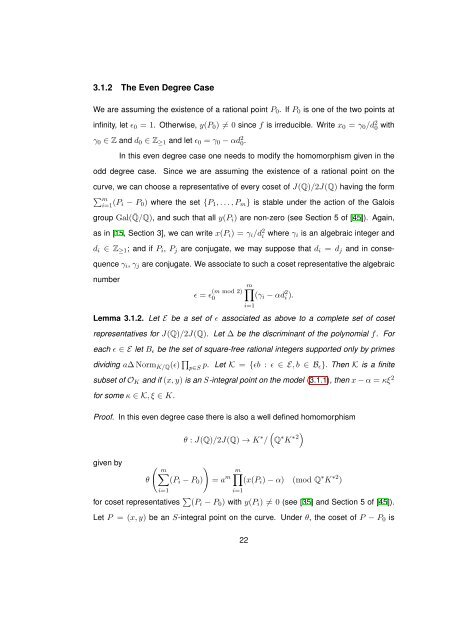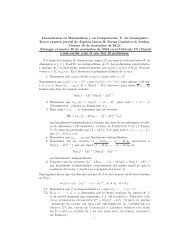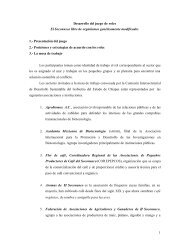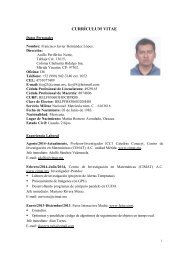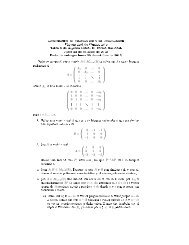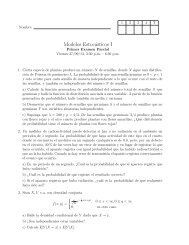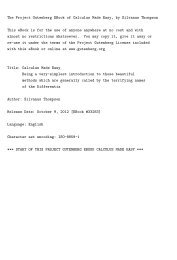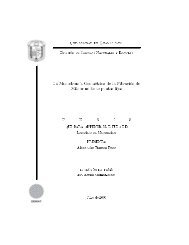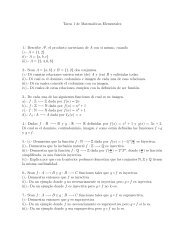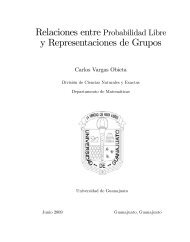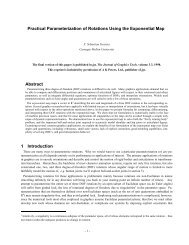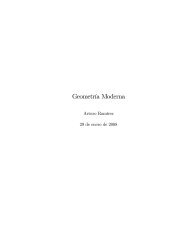S-integral points on hyperelliptic curves Homero Renato Gallegos ...
S-integral points on hyperelliptic curves Homero Renato Gallegos ...
S-integral points on hyperelliptic curves Homero Renato Gallegos ...
- No tags were found...
You also want an ePaper? Increase the reach of your titles
YUMPU automatically turns print PDFs into web optimized ePapers that Google loves.
3.1.2 The Even Degree CaseWe are assuming the existence of a rati<strong>on</strong>al point P 0 . If P 0 is <strong>on</strong>e of the two <str<strong>on</strong>g>points</str<strong>on</strong>g> atinfinity, let ɛ 0 = 1. Otherwise, y(P 0 ) ≠ 0 since f is irreducible. Write x 0 = γ 0 /d 2 0 withγ 0 ∈ Z and d 0 ∈ Z ≥1 and let ɛ 0 = γ 0 − αd 2 0 .In this even degree case <strong>on</strong>e needs to modify the homomorphism given in theodd degree case.Since we are assuming the existence of a rati<strong>on</strong>al point <strong>on</strong> thecurve, we can choose a representative of every coset of J(Q)/2J(Q) having the form∑ mi=1 (P i − P 0 ) where the set {P 1 , . . . , P m } is stable under the acti<strong>on</strong> of the Galoisgroup Gal( ¯Q/Q), and such that all y(P i ) are n<strong>on</strong>-zero (see Secti<strong>on</strong> 5 of [45]). Again,as in [15, Secti<strong>on</strong> 3], we can write x(P i ) = γ i /d 2 i where γ i is an algebraic integer andd i ∈ Z ≥1 ; and if P i , P j are c<strong>on</strong>jugate, we may suppose that d i = d j and in c<strong>on</strong>sequenceγ i , γ j are c<strong>on</strong>jugate. We associate to such a coset representative the algebraicnumber(m mod 2)ɛ = ɛ0m∏(γ i − αd 2 i ).Lemma 3.1.2. Let E be a set of ɛ associated as above to a complete set of cosetrepresentatives for J(Q)/2J(Q). Let ∆ be the discriminant of the polynomial f. Foreach ɛ ∈ E let B ɛ be the set of square-free rati<strong>on</strong>al integers supported <strong>on</strong>ly by primesdividing a∆ Norm K/Q (ɛ) ∏ p∈S p. Let K = {ɛb : ɛ ∈ E, b ∈ B ɛ}. Then K is a finitesubset of O K and if (x, y) is an S-<str<strong>on</strong>g>integral</str<strong>on</strong>g> point <strong>on</strong> the model (3.1.1), then x − α = κξ 2for some κ ∈ K, ξ ∈ K.Proof. In this even degree case there is also a well defined homomorphismi=1θ : J(Q)/2J(Q) → K ∗ /(Q ∗ K ∗2)given by ( m)∑∏mθ (P i − P 0 ) = a m (x(P i ) − α) (mod Q ∗ K ∗2 )i=1i=1for coset representatives ∑ (P i − P 0 ) with y(P i ) ≠ 0 (see [35] and Secti<strong>on</strong> 5 of [45]).Let P = (x, y) be an S-<str<strong>on</strong>g>integral</str<strong>on</strong>g> point <strong>on</strong> the curve. Under θ, the coset of P − P 0 is22


